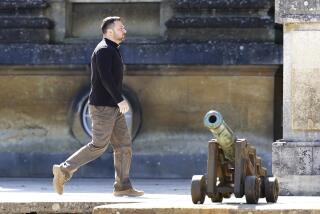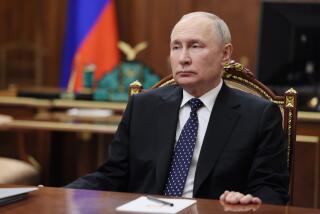Soviet Tanks Withdraw From Czechoslovakia
- Share via
FRENSTAT, Czechoslovakia — Twenty-two Soviet tanks left this northern Moravian city today, beginning the Red Army’s withdrawal from Czechoslovakia nearly 22 years after Moscow sent troops to crush “Prague Spring” reforms.
The pullout began as Czech President Vaclav Havel announced in Moscow today that the Soviet Union agreed to pull all its 73,500 troops out of Czechoslovakia by July 1 next year.
Few people came to wave goodby to the Soviet troops today, and those who did showed little emotion.
A brass band struck up the “Internationale,” the Communist anthem, during a brief ceremony inside the Soviet base at Frenstat that kicked off the first complete withdrawal of Soviet troops from any of Moscow’s allies.
The Soviet troops entered Czechoslovakia with a Warsaw Pact invasion that smashed the 1968 reforms. But in November, 1989, a peaceful revolution toppled the hard-line Communists and the new government immediately began talks on withdrawing all Red Army troops.
To Czechoslovaks, the Soviet troops “meant empty shelves in stores, polluted water, an occasional fight in the pub and a reminder that we are not a free country,” said Karel Micek, a spokesman for the Civic Forum movement.
The withdrawal from Frenstat pod Radhostem, 110 miles southeast of Prague, was accompanied by a parallel pullout from Krnov on the Czechoslovak-Polish border, 150 miles east of the Czechoslovak capital. They are to be completed by March 13 and March 25 respectively.
Havel, after meeting Soviet President Mikhail S. Gorbachev in Moscow, said the two countries’ foreign ministers, Eduard A. Shevardnadze and Jiri Dienstbier, had signed an agreement on the withdrawal.
Havel also said he and Gorbachev had signed a declaration on bilateral relations.
Havel told journalists that Gorbachev said it was possible Soviet troops would leave Czechoslovakia before the June 30, 1991, deadline set in the agreement and even as early as a year from now.
“He said it is quite possible they will leave fully within a year. But in the agreement we would leave the date as June 30 so that if they are unable to do it in a year it will not look as though either side were not fulfilling its obligations.”
The agreement provides for the departure of Soviet forces in three stages and for the majority of the troops to be out of Czechoslovakia by May 31 this year. The second phase would be completed by December and the third by July 1, 1991.
Czechoslovakia’s coalition government had originally demanded all Soviet troops out by the end of this year, but Havel told the U.S. Congress last week the most important thing was for most of them to go before elections in June.
More to Read
Sign up for Essential California
The most important California stories and recommendations in your inbox every morning.
You may occasionally receive promotional content from the Los Angeles Times.













